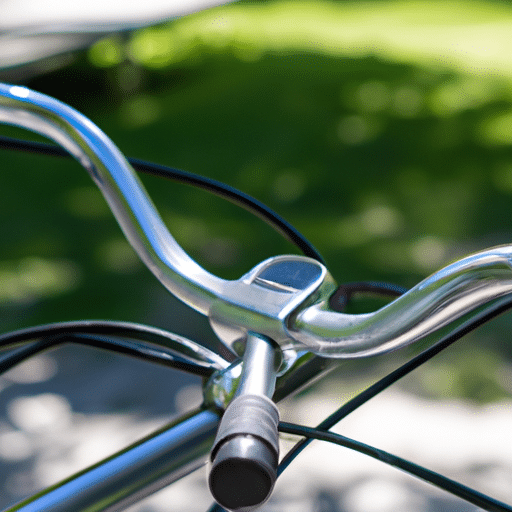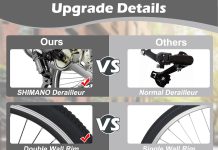Cruiser bikes have long been associated with leisurely rides along the beach or through quaint neighborhoods, but many still wonder if they are challenging to ride. Let us put those doubts to rest – cruiser bikes are not hard to ride at all!
These bicycles are designed with comfort and ease in mind, making them perfect for riders of all experience levels.
Whether an occasional rider or a seasoned cyclist, hopping on a cruiser bike is like rediscovering the joy of biking without stress or strain, so grab your helmet, and let’s hit the road for a smooth and effortless cruise on a charming cruiser bike!
Table of Contents
Types of Bikes
When choosing a bike, there are several options to consider. One popular type is the cruiser bike, known for its stylish design and comfortable riding experience. However, other types of bikes are also available, each with unique features and functionalities.
Cruiser Bikes
Cruiser bikes are a classic and timeless option for riders who prioritize comfort and style. These bikes are typically characterized by their relaxed riding position, wide handlebars, and comfortable seats. They are designed with a focus on leisurely riding, making them perfect for casual outings, beachside cruises, and neighborhood strolls.
Other Types of Bikes
While cruiser bikes offer a relaxed and comfortable riding experience, other types of bikes cater to different riding preferences and needs. These include mountain, road, and hybrid bikes, each designed with specific features to excel in their respective domains.
Mountain bikes are built to conquer rugged terrains and off-road trails, with features like sturdy frames, suspension systems, and knobby tires for enhanced traction.
On the other hand, road bikes are designed for speed and efficiency on paved surfaces, boasting lightweight frames, sleek aerodynamics, and narrow tires. Hybrid bikes combine elements of mountain and road bikes, offering versatility for riders who enjoy a bit of everything, whether it’s commuting, leisure rides, or light trail exploration.
Features of Cruiser Bikes
Cruiser bikes are known for their unique features, contributing to their comfortable and laid-back riding experience. Let’s take a closer look at some of these notable features:
Design and Frame
Cruiser bikes often feature a classic design that harkens back to the retro beach cruisers of the mid-20th century. These bikes typically have a step-through frame, making it easy to mount and dismount. Some cruiser bikes also come in a men’s or women’s frame, with slightly different geometry to accommodate varying riding styles.
Upright Riding Position
One of the defining features of cruiser bikes is their upright riding position. Unlike road bikes or mountain bikes that prioritize a more aerodynamic and aggressive stance, cruiser bikes allow riders to sit in a relaxed and comfortable posture. This upright position promotes better visibility and reduces strain on the back and neck, making for a more enjoyable ride.
Wide Handlebars
Another distinct feature of cruiser bikes is their wide handlebars. These handlebars give riders a wider grip, giving a sense of stability and control. They also allow for a more relaxed arm and shoulder position, reducing fatigue on longer rides.
Low Center of Gravity
Cruiser bikes often have a low center of gravity, which contributes to their stability and ease of handling. The position of the rider, combined with the design of the bike’s frame, helps ensure a smooth and balanced ride, especially at slower speeds.
Comfortable Seat
When it comes to comfort, cruiser bikes excel with their plush and wide seats. These seats are designed to provide ample cushioning, ensuring a smooth and comfortable experience even on longer rides. The relaxed seating position and the comfortable seat make cruiser bikes ideal for leisurely trips, whether a short tour around town or a more extended adventure along the coast.
Coaster Brake
Cruiser bikes often come equipped with a coaster brake, a type of rear brake that engages when you pedal backward. This simple braking system adds to the convenience and ease of riding a cruiser bike, allowing riders to slow down or come to a complete stop without needing hand brakes.
Single Speed
In keeping with their simplistic and leisurely nature, many cruiser bikes feature a single-speed drivetrain. This means that there is only one gear to choose from, making it easier to pedal and maintain a consistent speed. This simplicity is ideal for riders who prioritize ease of use and are looking for a straightforward and hassle-free riding experience.
Balloon Tires
Cruiser bikes are often equipped with balloon tires, which are broader and more voluminous than tires found on other types of bikes. These wide tires provide added cushioning and shock absorption, resulting in a smoother and more comfortable ride. Additionally, the increased surface area of the tires improves traction, making them suitable for various surfaces, including pavement, gravel, and even sandy paths.
Fenders
Many cruiser bikes come with fenders to protect riders from splashes and debris. These fenders are positioned above the wheels and help prevent water, mud, or other particles from splashing onto the rider or the bike’s components. Fenders can be especially beneficial when riding in wet conditions or on unpaved surfaces.
Optional Accessories
Cruiser bikes offer a range of optional accessories to customize further and enhance the riding experience. From baskets and racks to cup holders and bells, these accessories allow riders to personalize their bikes and make them even more functional and enjoyable.
Differences from Other Bikes
While cruiser bikes have distinct features, they also differ from other types of bikes in several ways. Let’s explore the differences between cruiser, mountain, road, and hybrid bikes.
Mountain Bikes
Unlike cruiser bikes, designed for leisurely and relaxed rides, mountain bikes are built to handle rough terrains and off-road trails. Mountain bikes typically have front and rear suspension, knobby tires for improved traction, and a more comprehensive range of gears to tackle steep climbs and fast descents. The riding position on a mountain bike is more inclined, facilitating better control and maneuverability over uneven terrain.
Road Bikes
On the other hand, road bikes are designed for speed and efficiency on paved surfaces. They typically have lightweight frames, drop handlebars for an aerodynamic riding position, and narrow tires for reduced rolling resistance. Road bikes are optimized for covering long distances at high speeds, making them ideal for racing, endurance, and fast-paced group rides.
Hybrid Bikes
Hybrid bikes, as the name suggests, combine elements of both mountain bikes and road bikes. They are designed to offer the versatility and comfort needed for a variety of riding conditions.
Hybrid bikes typically have a more upright riding position, wider tires for enhanced stability, and a broader gear range than cruiser bikes. These bikes suit commuting, casual rides, and light off-road adventures.
Ease of Riding
Cruiser bikes are often praised for their ease of riding, especially for beginners or riders seeking a more relaxed and comfortable experience. Let’s explore some aspects of riding where cruiser bikes excel:
Stability
One of the critical advantages of cruiser bikes is their inherent stability. The low center of gravity and the wide balloon tires provide a solid and stable platform, which is particularly beneficial for riders who may feel less confident on bikes with a more aggressive riding position or narrower tires.
Slow Speed Maneuverability
Cruiser bikes shine when it comes to maneuvering at slower speeds. Whether navigating a crowded city street or making tight turns on a neighborhood sidewalk, the relaxed riding position and wide handlebars of a cruiser bike make it easier to maintain balance and control.
Climbing Hills
While cruiser bikes may not be the first choice for conquering steep slopes, they can still handle moderate inclines with ease. The single-speed drivetrain, combined with the comfortable riding position, allows riders to maintain a steady pace while climbing hills without exerting excessive effort.
Riding on Uneven Terrain
Although cruiser bikes are primarily designed for paved surfaces, they can handle occasional rides on uneven terrain. The wide balloon tires and shock-absorbing qualities provide a smooth and comfortable ride, making them suitable for traversing gravel paths, packed dirt trails, or cobblestone streets.
Turning and Handling
Cruiser bikes are incredibly responsive when it comes to turning and handling. The broader handlebars allow for greater steering leverage, making navigating corners easier and quickly adjusting as needed. The combination of stability, agility, and the cruiser bike’s unique frame geometry ensures a pleasurable and effortless riding experience.
Stopping and Coasting
With their coaster brake system, stopping a cruiser bike is as simple as pedaling backward. The intuitive nature of this braking mechanism provides a sense of control and makes it easy to come to a smooth and controlled stop. The relaxed riding position and comfortable seat make coasting on a cruiser bike a delightful and leisurely experience.
Factors Affecting Difficulty
While cruiser bikes provide a user-friendly and enjoyable riding experience, several factors can affect the perceived difficulty of riding one. It’s essential to consider these factors when choosing a bike and setting expectations for your riding experience:
Size and Weight
The size and weight of the cruiser bike can affect how easy it is to ride. Choosing a bike that fits your body proportions and allows you to maintain a comfortable and balanced riding position is essential. Additionally, some cruiser bikes may be heavier than other types of bikes due to their design and construction. While this added weight contributes to stability, it may require more effort when accelerating or climbing uphill.
Fitness Level
The rider’s fitness level can impact the ease of riding any bike, including cruisers. Maintaining a consistent pedaling pace and maneuvering a bike effortlessly requires cardiovascular fitness and muscle strength. However, cruiser bikes are generally designed for leisurely rides and are suitable for riders of various fitness levels.
Experience and Skill
Riding any type of bike, including cruiser bikes, requires a certain level of experience and skill. Familiarizing yourself with the bike’s controls, learning how to balance, and understanding how to maneuver safely is essential for a smooth and enjoyable ride. For beginners, it may take some practice and getting used to before feeling completely comfortable on a cruiser bike.
Terrain and Riding Conditions
The terrain and riding conditions can also influence the cruiser bike’s difficulty. While cruiser bikes are primarily designed for paved surfaces, they can handle rides on various terrains.
However, a cruiser bike may not be the most suitable choice if you plan to tackle challenging off-road trails or hilly environments. Understanding the limitations of your bike and choosing the appropriate terrain will ensure a safe and enjoyable riding experience.
Tips for Riding Cruiser Bikes
To make the most out of your cruiser bike riding experience, here are a few tips to keep in mind:
Start Slow and Practice
If you’re new to riding a cruiser bike, start by taking it slow and gradually build your confidence. Find a quiet area or an empty parking lot where you can practice maneuvering, braking, and getting comfortable with the bike’s controls. Take your time and enjoy the learning process.
Find Your Balance
Maintaining balance on a cruiser bike is crucial for a smooth and enjoyable ride. Practice balancing by riding in a straight line and gradually progress to making turns and navigating obstacles. You’ll develop a better sense of balance and control as you become more comfortable.
Learn to Coast and Brake
Get familiar with the coaster brake system on your cruiser bike. Practice coasting, which essentially involves pedaling backward to slow down or come to a stop. Experiment with different levels of braking force to find the right balance between control and comfort. Remember, practice makes perfect!
Use Proper Riding Techniques
Learning and applying proper riding techniques will significantly enhance your riding experience. Maintain an upright posture, distribute your weight evenly, and engage your core muscles for stability. Use a relaxed grip on the handlebars and avoid unnecessary tension in your arms and shoulders.
Handle Turns with Confidence
Mastering turns is essential for any rider. Approach turns with confidence, using your body weight and handlebars to guide your bike smoothly through the turn. Start with wider turns and gradually progress to sharper ones as you gain more experience and confidence.
Maintain a Comfortable Riding Posture
Cruiser bikes are all about comfort, so maintain a comfortable riding posture. Relax your arms and shoulders, engage your core muscles, and adjust the seat height if necessary. Listen to your body and adjust as needed to avoid strain or discomfort.
Choose Suitable Gearing
While many cruiser bikes have a single-speed drivetrain, some models may offer multiple gear options. When riding in different terrain or facing varying levels of inclines, selecting the appropriate gear can make your ride more efficient and enjoyable. Experiment with different gears to find the right balance between pedaling effort and speed.
Stay Alert and Be Aware of Surroundings
Like any bike, staying alert and aware of your surroundings is essential. Observe traffic rules, watch out for pedestrians, and be mindful of other cyclists sharing the road. Always use hand signals when turning or changing lanes to communicate your intentions.
Stay within Your Abilities
While cruiser bikes are generally accessible, knowing and respecting your limitations is essential. Don’t push yourself beyond what you’re comfortable with or attempt challenging terrain until you’ve built up the necessary skills and confidence. Gradually expand your riding abilities as you gain experience and feel more at ease.
Seek Advice and Guidance
If you’re unsure about any aspect of riding a cruiser bike, don’t hesitate to seek advice and guidance. Experienced cyclists or bike shop professionals can provide valuable insights and help you make informed decisions about your bike setup, riding techniques, and recommended routes. Learning from others’ experiences can assist you in having a safe and enjoyable time on your cruiser bike.
Common Misconceptions
Despite their popularity, there are a few common misconceptions about cruiser bikes that are worth dispelling:
Cruiser Bikes are Only for Leisurely Rides
While cruiser bikes are excellent for leisurely rides, they are not exclusively limited to that purpose. The comfortable and relaxed nature of cruiser bikes makes them ideal for everyday commuting, running errands, or exploring your neighborhood. They can handle various riding conditions and are incredibly versatile for various purposes.
Cruiser Bikes are Only for Beginners
While cruiser bikes are well-suited for beginners due to their ease of riding and comfortable design, they can be enjoyed by riders of all skill levels. Experienced cyclists can also appreciate the laid-back and enjoyable experience of riding a cruiser bike, whether it’s for a casual ride along the beach or a relaxing spin through the park.
Cruiser Bikes are Heavy and Slow
While it’s true that cruiser bikes may be heavier compared to some other types of bikes, their weight contributes to stability and comfort. The wider tires, plush seats, and relaxed riding position all work together to provide a smooth and enjoyable ride. As for speed, cruiser bikes may not be the fastest option, but they can maintain a comfortable cruising speed for leisurely rides.
Final Verdict
In conclusion, cruiser bikes are not hard to ride. Their comfortable design, relaxed riding position, and unique features offer a pleasant riding experience for riders of various skill levels.
Cruiser bikes provide stability, slow-speed maneuverability, and comfort, making them ideal for leisurely rides, casual outings, and exploring your surroundings.
By understanding the features, differences, and tips for riding a cruiser bike, you can make an informed decision and embark on a fun-filled biking adventure. So hop on a cruiser bike, embrace the laid-back style, and enjoy the journey ahead!





































